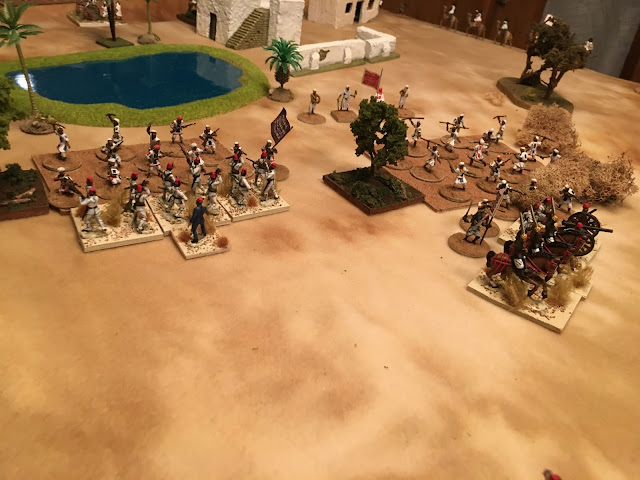We finally got around to doing the game after numerous cancellations. My friend Jim brought over his excellent collection of Mahdists and we were ready to go.
I was the game master as well as one of the Egyptian commanders. My command would be all the mounted Egyptians while my friend Mike commanded the infantry and artillery. Mike and I played the part of Hicks and his staff of European officers. Mike was not all that keen on our "walk down the Nile" and I can't say I'd blame him given the numerous handicaps I had assigned to the Egyptian force. (They were not rated nearly as effective as they are in the TMWWBK lists.)
My friend Jim and my son Justin commanded the forces of the Mahdi with each of them having a Rub (pronounced Roob) each. The handicaps assigned to the Mahdists were variable leadership skills as the tactical level. (They had a number of units that turned out to be poorly led.) On a higher level the Mahdists only had two Rubs present at the start of the game while the other two had to be diced for. Since the remaining two were supposed to be deployed to the side of traveling Egyptian square the idea was to not make it too easy for all the Rubs to attack at once.
The Egyptian battle plan recognized that we had a little time so we elected to try and break through the Rub to our front before the other Rubs could effectively surround us.
In addition to having sub-standard firing factors the terrain hindered the Egyptian line of sight. Historically the Mahdists were able to get very close to the Egyptians. I reflected this advantage by making all the terrain of the type where it was difficult to sight the stealthy Mahdists.
Never-the-less, Mike and I thought we had a chance to bull our way through.
The pictures below are not in any particular order because it is hard to be a game master and take pictures and then get them in sequence with appropriate comments.
 |
| Close up of one of the flanking Rubs. Two of the three units are the nasty Beja Hadendowa. |
 |
| Egyptian camelry, infantry and artillery approach the oasis held by the Black Flag Rub (pronounced Roob) |
 |
| The Green Flag Roob advances! |
 |
| Egyptian forces try to form a square. Pasha Hicks and his staff try to direct a defense but it does not look good. |
 |
| Pinned Egyptian camelry is about to be charged by Arab camelry and die valiantly! |
 |
| The empty space represents the space where Egyptian units perished. |
 |
| The Blue Flag Rub comes in on the other flank. There is no way out! |
 |
| The Black Flag Rub counter attacks against the rapidly crumbling Egyptian lines. |
 |
| This will not go well for the fellahin! |
 |
| It won't be long to complete the massacre. |
 |
| Egyptian Gendarme lancers at the start of the game looking sharp but that won't save them. |
 |
| Fellahin at the ready supported by the Khedive's Cuirassiers. |
 |
| Tough Sudanese! |
 |
| One of the Krupp breechloaders that would prove mostly ineffective. |
 |
| Camel troops are usually mounted infantry in the rules. |
 |
| A smoothbore artillery piece as an anchor. |
 |
| Bashi Bazouks, bandits really. Probably just burned down a village. |
 |
| Hicks and staff ready to die to a man and they would. |
 |
| Khedive's Cuirassiers |
 |
| The Square |
 |
| The Square |
 |
| Nice close up of the Egyptian camel corps. |
 |
| Fellahin close up |
 |
| Sudanese close up |


No comments:
Post a Comment